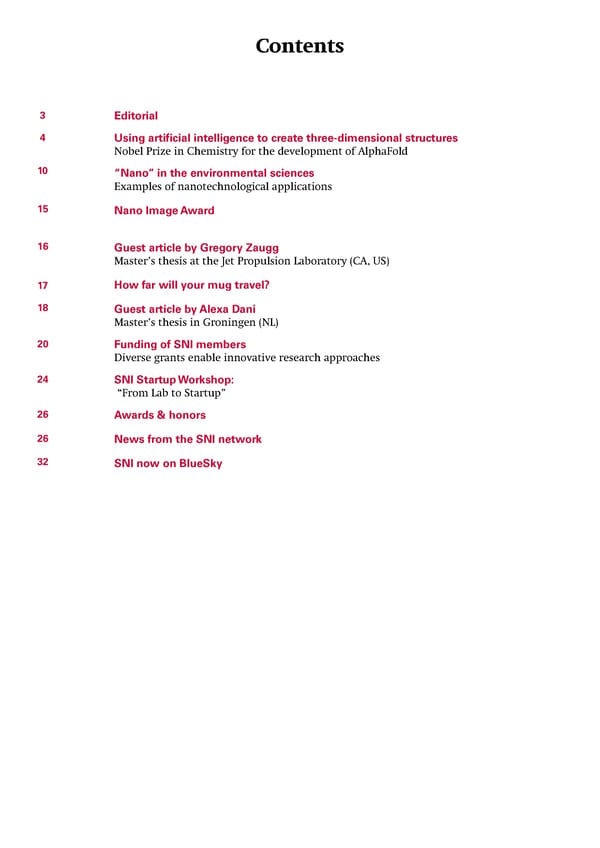SNI INSight December 2024
Showcasing research and activities at the Swiss Nanoscience Institute
nano
nanoscience
nanotechnology
Swiss Nanoscience Institute
University of Basel
innovation
nano network
SNI INS ight Showcasing research and activities at the Swiss Nanoscience Institute December 2024 Application Interdisciplinarity Experience Innovation Arti昀椀cial intelligence for Environmental science Two guest articles New concept for SNI PhD protein structure projects, in which “nano” on master’s theses School workshop prediction plays a role
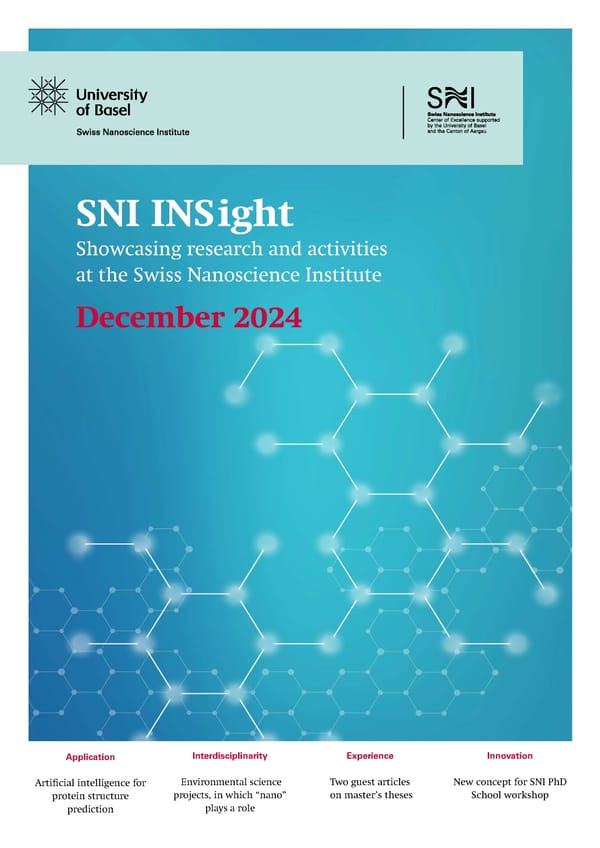
Contents 3 Editorial 4 Using artificial intelligence to create three-dimensional structures Nobel Prize in Chemistry for the development of AlphaFold 10 “Nano” in the environmental sciences Examples of nanotechnological applications 15 Nano Image Award 16 Guest article by Gregory Zaugg Master’s thesis at the Jet Propulsion Laboratory (CA, US) 17 How far will your mug travel? 18 Guest article by Alexa Dani Master’s thesis in Groningen (NL) 20 Funding of SNI members Diverse grants enable innovative research approaches 24 SNI Startup Workshop: “From Lab to Startup” 26 Awards & honors 26 News from the SNI network 32 SNI now on BlueSky
Editorial tive Committee, we approved the 昀椀ve new applied proj- ects recommended by the advisory committee, as well as 昀椀ve extensions. In addition to these diverse topics relating to SNI research, this edition of SNI INSight includes two guest articles from former nanoscience students. Alexa Dani reports on her master’s thesis in Groningen, and Gregory Zaugg on his master’s thesis at NASA — both of which are excellent examples of the opportunities available to those studying nanosciences in Basel. With that, I’d like to wish you all a happy holiday season and a good start to what will hopefully be a healthy and inspiring New Year. It’s a privilege to be part of this dy- namic, interdisciplinary network — and I’d like to thank you all for your excellent work and commitment to the SNI and to nanoresearch in general. I look forward to en- joying many further activities and interactions within the SNI network over the coming year. Dear colleagues and nanoenthusiasts, Kind regards, As the year draws to a close, I’m delighted to present an- other SNI INSight packed full of information on research from our network. This edition kicks o昀昀 with an inter- view on the arti昀椀cial intelligence known as AlphaFold, whose developers were recently awarded the Nobel Prize in Chemistry after their AI revolutionized the prediction Professor Martino Poggio, SNI Director of three-dimensional protein structures. AlphaFold is also used by numerous researchers within our network, and we look at a few examples in this edition. We then turn our attention to the topic of “nano and the environment.” Through a series of examples, we show how SNI projects are contributing to positive devel- opments in the environmental sciences and where there is a need for further research. In the previous edition of SNI INSight, we incor- porated a new section where we report on grants awarded to SNI members in recent months. With this information on wide-ranging research topics within our network, we hope to promote the 昀氀ow of information and collabora- tion within the network. Perhaps this will also provide us with some inspiration for joint research projects. SNI events such as the Annual Event and the NanoTec Apéro — both of which were held in the second half of this year — also provide ideal platforms for net- working and the exchange of ideas. For the Annual Event, we met at Lake Hallwil for the second time, and this year’s NanoTec Apéro was also held in the Canton of Aargau. Heartfelt thanks go to the team of the newly opened Park Innovaare, who hosted this event and paved the way for a fascinating, interdisciplinary dialog regarding Nano-Argo- via projects. New Nano-Argovia projects will also be launched in the coming year. Indeed, in the recent meeting of the Execu- SNI INSight December 2024 3
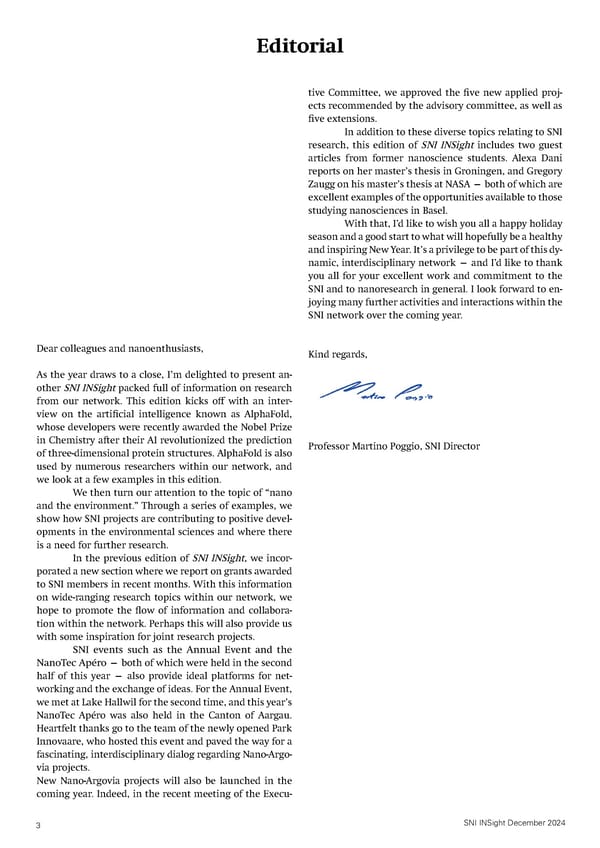

Using arti昀椀cial intelligence to create Further information three-dimensional structures AlphaFold Nobel Prize in Chemistry for the development https://alphafold.ebi.ac.uk Nobel Prize of AlphaFold https://www.nobelprize.org Publications in Nature This year’s Nobel Prize in Chemistry went in part to Demis Hass- https://www.nature.com/ articles/d41586-019-01357-6 abis and John Jumper from Google’s DeepMind research center. https://www.nature.com/arti- The two scientists were instrumental in developing AlphaFold, cles/d41586-024-03708-4 an arti昀椀cial intelligence (AI) that allows researchers worldwide to predict the three-dimensional structure of proteins based on the sequence of amino acids. This AI is also being used by several teams in the SNI network. To 昀椀nd out more about AlphaFold and its applications, we spoke to Dr. Janani Durairaj from the group led by Professor Torsten Schwede (Biozentrum) and Professor Timm Maier (Biozentrum). SNI INSight: Why is it important to ana- lyze the three-dimensional structure of a protein? Timm Maier: The three-dimensional struc- ture of a protein determines how it interacts with other molecules in its environment. This structure is a key element in the speci- 昀椀city, activity and regulation of proteins. In the case of an enzyme, for example, the shape of the binding site must perfectly match the substrate to which it binds. If the shape of an enzyme changes, the catalyzed re- action can be blocked. The three-dimensional structure is also crucial for the formation of larger protein complexes and for proteins that ful昀椀ll other functions. If it changes due Timm Maier explains why the three-dimensional struc- to mutations, chemical modi昀椀cations or en- ture of a protein is so important. vironmental in昀氀uences, this can have serious consequences for the function of the protein and thus for the entire organism. Knowledge of the protein structure SNI INSight: What did the Nobel Prize win- helps researchers when it comes to devel- ners Demis Hassabis and John Jumper oping drugs that interact with proteins and develop? either block or intensify their activity or to developing proteins with new or improved Janani Durairaj: The two researchers have functions. contributed signi昀椀cantly to the development of the arti昀椀cial intelligence AlphaFold2, which can predict the spatial structure of proteins of which only the amino acid se- quence is known. 4 SNI INSight December 2024
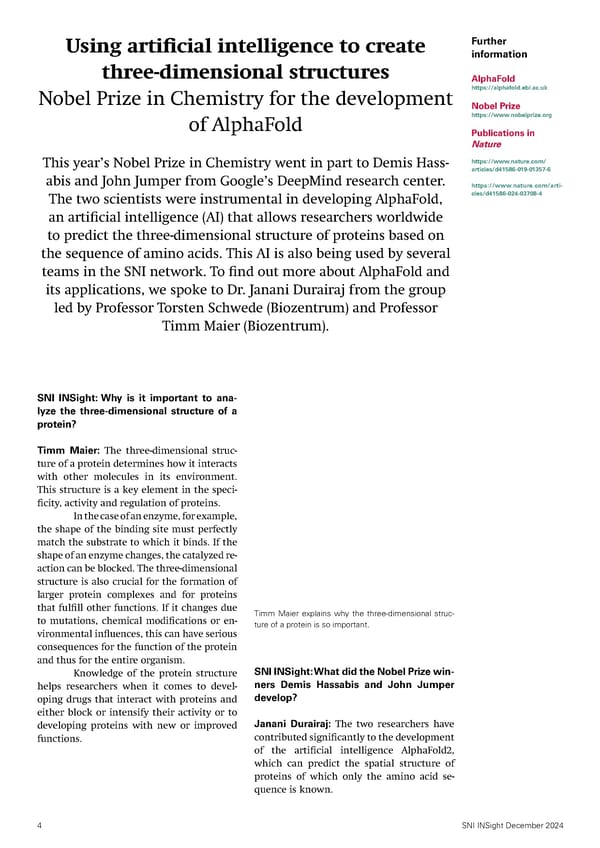
What are proteins? Proteins are vital engines of life that are found in all Proteins consist of amino acids, of which there are 20 living beings. They have wide-ranging functions in the standard varieties. These acids are strung together in body and play an essential role in most biological pro- long chains by peptide bonds to form what is known cesses. For example, they act as catalysts in the form as the primary structure. Due to interactions between of enzymes and make numerous chemical reactions the backbone groups of the amino acids, a folded sec- possible in the 昀椀rst place. As collagen, they give cells ondary structure is formed (e.g., an alpha-helix). As the and tissues their shape and strength. They protect us side chains of the amino acids also interact with one an- from infections in the form of antibodies, serve as other, proteins also form a three-dimensional (tertiary) hormones, and transmit information. Proteins trans- structure, which plays a decisive role in how the protein port oxygen in the form of hemoglobin and are also functions. In many cases, a protein consists of sever- involved in muscle contraction and cell movement. Life al of these 3D polypeptide chains, which then form a is not possible without them. complex in the quaternary structure. Hemoglobin, for example, consists of four polypeptide chains. SNI INSight: How does AlphaFold work? Janani Durairaj: AlphaFold uses neural networks to predict the 3D structure of proteins. It takes the amino acid sequence of the protein in question and searches for similar sequences in a huge database, which now con- tains over a billion sequenced proteins from wide-ranging organisms. Here, AlphaFold searches for “coevolutionary signals” — amino acid pairs that have changed together over the course of evolution. The idea of using coevolution to predict structures has existed since before the 1990s. Researchers noticed that amino acid pairs that have always changed together are usually in contact with one another in the three-di- mensional protein structure. Conversely, the assumption is that such pairs probably evolve together if they are in contact with one another. Based on these assumptions, AlphaFold then predicts an initial 3D structure that would best match the evolutionary manifestation of the input protein sequence. Using a second database, containing some As part of her research, Janani Durairaj works with AlphaFold. 200,000 empirical protein structures, AlphaFold2 then continually learns which amino acid sequences result in which protein structure. By developing this sophisticated internal model, which maps the coevolutionary signal to known protein structures, AlphaFold2 is able to use the At the end, AlphaFold2 provides a detailed 3D model of same model to predict unknown structures. the protein that shows how the di昀昀erent parts of its struc- The AI recognizes patterns by measuring distanc- ture (such as loops, helices and lea昀氀ets) assemble to form es and angles between the di昀昀erent amino acids and ana- a functional shape. lyzes interactions between them, taking the amino acids and hence their chemical properties (e.g., hydrophilic or hydrophobic) into account. It is getting better and better SNI INSight: Is AlphaFold freely accessible? at understanding how individual amino acids interact with one another and whether an amino acid chain bends, Timm Maier: After the scienti昀椀c publication, there was knots or forms a loop as a result of the interaction. Based a certain delay in releasing the source code for the latest on this, the AI calculates how the protein folds together versions of AlphaFold, but it has now been available since in space. SNI INSight December 2024 5
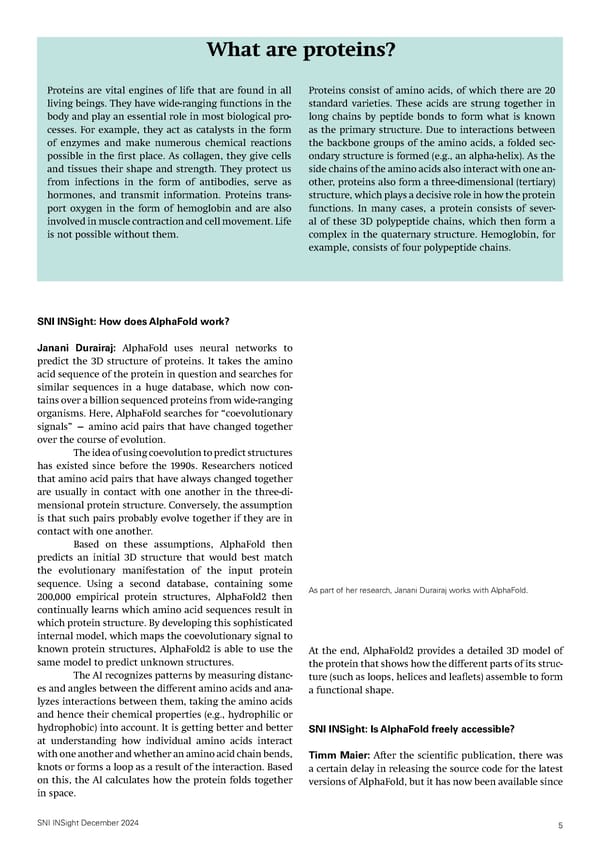
November. As with many other AI products, AlphaFold SNI INSight: How long does analysis with AlphaFold is based on freely available data that was largely gener- take? ated by academic institutions. Unlike the data used for training, the use of the trained models is now limited Janani Durairaj: The DeepMind team worked with to noncommercial applications — which poses the risk the European Bioinformatics Institute of the European of a potential monopolization of the new methods. In Molecular Biology Laboratory (EMBL-EBI) to set up the numerous projects, however, the scienti昀椀c community is AlphaFold database, which contains predictions for over already working to make equivalent methods available 200 million protein sequences. Users receive the predict- on an open-source basis as well. ed structure within seconds of entering the name of the protein. The time taken to predict the structure of a spe- SNI INSight: What is the resolution of the predicted ci昀椀c sequence not in this database depends on the length 3D structures? of the protein and the available computing resources. It varies between minutes and hours — signi昀椀cantly less Janani Durairaj: The resolution of protein structures is than the months and years needed for experimental 10 structural elucidation. generally measured in units of angstroms (10- m). These are of an order of magnitude that corresponds to the One very useful community resource is ColabFold, range of interatomic distances. Experimental methods an interactive web-based platform where users enter a of structural determination such as X-ray crystallography protein sequence and receive a structure predicted by achieve accuracies of up to 1 angstrom (Å). In monomer- AlphaFold with no need for an installation process or ic proteins (proteins with only one amino acid chain), computing resources. AlphaFold can also achieve this level of accuracy and therefore delivers results within the margin of error of experimental methods. SNI INSight: How reliable are AlphaFold’s predictions? Timm Maier: Janani Durairaj: With every structural prediction, Alpha- We should bear in mind that most proteins consist of Fold provides a quality estimate that helps us classify the multiple amino acid chains and that, in many cases, an reliability of the prediction. “average” accuracy is not very meaningful. For example, There are two key reasons for lower quality pre- individual mutations in a reactive center of an enzyme dictions. On the one hand, proteins are highly 昀氀exible can change the substrate speci昀椀city completely. As an av- and dynamic. The static structure we normally see there- erage across all amino acids, however, this only changes fore re昀氀ects only a single point in time or one possible the overall structure by a fraction of an angstrom. conformation of the protein. Some regions of proteins are in constant motion and are described as being in- trinsically disordered so attempts to assign a 昀椀xed set of SNI INSight: You’ve mentioned huge amounts of data. 3D coordinates to these regions do not make sense and What sort of scale are we talking about? would not produce interpretable results. On the other hand, there are many proteins for Janani Durairaj: If we consider all possible 3D confor- which only a few coevolutionary signals exist. Since mations that a protein can adopt, we’re talking about an astronomical number of possible conformations. For example, even with some underestimations, a protein with 100 amino acids could theoretically result in over 198 3 di昀昀erent conformations. It is therefore impossible to enumerate these conformations as an algorithmic solu- tion for predicting protein structures. Seen from another perspective, the “se- quence-structure gap” means that although sequencing projects operating around the world have provided mil- lions of protein sequences from wide-ranging organisms, researchers have only determined hundreds of thousands of empirical protein structures. This is because each structure can take years of complex studies to solve. By learning from these sequences and structures, AlphaFold allows high-accuracy predictions for many mil- lions of sequences, bringing us much closer to closing the Janani Durairaj, who is setting up her own research group as an Ambi- gap with plausible hypotheses. zione fellow, has worked intensively on the creation of the “Protein Uni- verse Atlas”. This is a web service that allows users to navigate through a universe of millions of known proteins. SNI INSight December 2024 6
AlphaFold uses these signals as the basis for its predic- We also use nuclear magnetic resonance (NMR) for struc- tions, however, good predictions are not possible if such tural elucidation — particularly for small proteins in solu- signals are only sparingly available. AlphaFold therefore tion and to investigate interactions and their dynamics has its limitations — for example, when predicting in the cell. Using NMR with large proteins is di昀케cult and structures of viral proteins, antibody-antigen complex- time-consuming, however, and the technique relies on es, or when analyzing the in昀氀uence of mutations on a isotope marking. On the other hand, NMR is highly e昀昀ec- structure. There are also limitations when it comes to tive for rapidly “testing” folds or for speci昀椀cally “reading” investigating the binding of biological or synthetic mol- certain properties. ecules, such as when searching for new medications. Each of these methods has speci昀椀c advantages The con昀椀dence values provided by AlphaFold and disadvantages. The choice of method depends on usually re昀氀ect these uncertainties, enabling us to focus on the type of protein, the availability of resources and the the proteins or parts of proteins for which the prediction desired level of detail of the structure. is reliable and to show the cases where good predictions are not possible. SNI INSight: Are these methods now being replaced by AlphaFold? SNI INSight: What methods exist for experimental structural elucidation? Janani Durairaj: Experimental methods and AlphaFold complement one another. Timm Maier: Recent years have also brought huge ad- One useful analogy here is that of Wikipedia vances in experimental methods of structural elucidation. vs. ChatGPT. Carefully veri昀椀ed experimental structures X-ray crystallography continues to play a key role and is would correspond to Wikipedia in this analogy, while the ideally suited to delivering high-resolution structures of predictions made with AlphaFold correspond to ChatGPT. small protein molecules with a high throughput. With The veri昀椀ed experimental structures contain copious in- the Swiss Light Source at the Paul Scherrer Institute, for formation on speci昀椀c biologically relevant interactions example, we can analyze around a hundred proteins in and mechanisms for a smaller subset of known proteins. the space of a week — provided we have crystals to hand. AlphaFold2, on the other hand, delivers predictions for a X-ray crystallography is also ideal for fascinating special far greater number of proteins for which no experimental applications such as the analysis of metal ions. With the structures yet exist providing very good starting points SwissFEL X-ray free-electron laser, it is even possible to for further detailed study. track dynamic processes such as the binding of molecules in real time. Timm Maier: On the contrary, AlphaFold and related Larger proteins are a job for cryo-electron mi- methods represent a key contribution to the necessary fur- croscopy (cryo-EM), which now allows us to image even ther development of experimental analysis. Some 20–30 very large protein complexes and thereby to gain precise years ago, experimental structural determination focused information about their structure. On the downside, cryo- on elucidating new fundamental protein folds. In those EM is nowhere near as fast as X-ray crystallography and days, the aim was to take data from genome research and generates incredibly large volumes of data that we have use it to explore the fold space of proteins. This process to save for a long time — which represents an enormous has long since been completed. Today, experimental struc- cost factor. tural biologists are addressing how dynamic interactions and various functional states of proteins help make cellu- lar life possible — ideally by considering proteins in their natural environment within the cell. Here, AI-generated models of the folding of individual proteins are a useful tool when it comes to recognizing certain proteins in a cell. At the same time, machine learning methods also allow researchers to design new proteins on the computer that perform very speci昀椀c tasks — such as breaking down a speci昀椀c plastic. We recently demonstrated for the 昀椀rst time in a block course how well this protein design pro- cess now works and how quickly we can arrive at astonish- ing results and completely novel proteins. Experimental structural elucidation is then needed in order to optimize the protein design and improve the design methods. In Timm Maier and his team combine experimental and computer-assisted this sense, machine learning actually creates additional methods such as AlphaFold to study isolated proteins and proteins in demand for experimental structural elucidation. cells in order to gain a better understanding of the dynamics and function in the cell. SNI INSight December 2024 7
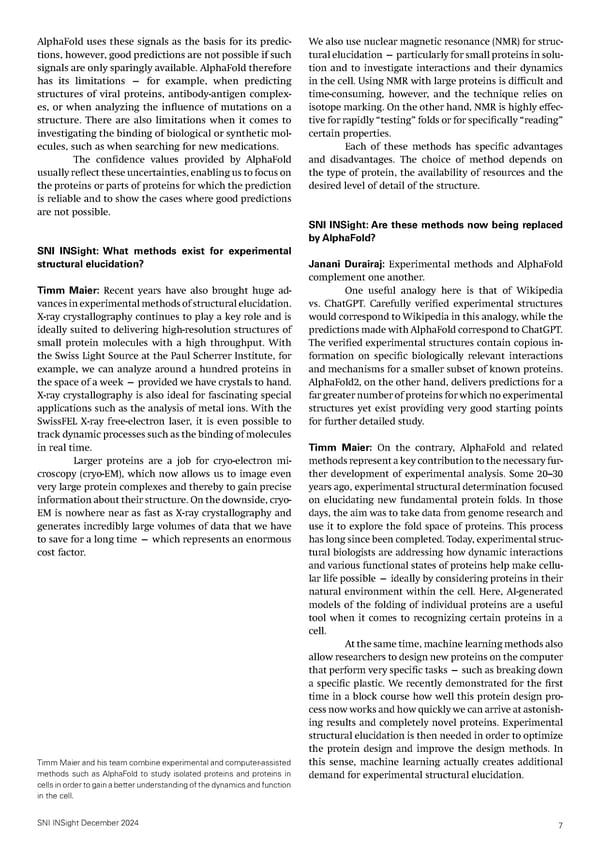
Further Examples of AlphaFold information Research group applications by SNI members Timm Maier https://www.biozentrum. unibas.ch/about/adminis- tration/administration-a-z/ overview/unit/research-group- timm-maier Research group Sebastian Hiller https://www.biozentrum.uni- bas.ch/about/administration/ administration-a-z/overview/ unit/research-group-sebas- tian-hiller Timm Maier’s research focuses on the architecture and functional principles of multienzymes and regulatory protein complexes. Understanding protein metabolism mography to study CO 昀椀xation and pho- 2 In their research, Professor Maier’s team tosynthesis. The researchers use AI tools to (Biozentrum, University of Basel) focus on interpret the 3D images that they acquire the architecture and functional principles inside various algae species. AlphaFold helps of multienzymes and regulatory protein them understand the structures of protein complexes — such as the mTOR complex. complexes that they see inside the cells. The researchers combine experimental and computer-aided methods such as Alpha- Fold to analyze both isolated proteins and proteins in cells with a view to gaining a better understanding of their dynamics and function within the cell. This fundamental understanding of metabolism and metabol- ic regulation directly shows potential appli- cations of new medicines. The group led by Professor Sebastian Hiller (Biozentrum, University of Basel) uses Alpha- Fold to predict protein structures, including not only individual proteins but also oligo- mers and protein complexes. For example, the researchers are analyzing the proteins of the outer membrane of bacteria, which are produced by a conveyor belt of “chaper- ones.” Here, the AI serves to form hypoth- eses, validate results and identify relevant objectives — e.g., for the development of new antibiotics. Interpretation of data Ben Engel (left) and SNI PhD student Philippe Van der Professor Ben Engel’s team (Biozentrum, Stappen (right) are checking cultures of algae, which have evolved powerful mechanisms for ef昀椀cient CO University of Basel) uses cryo-electron to- 2 昀椀xation. 8 SNI INSight December 2024
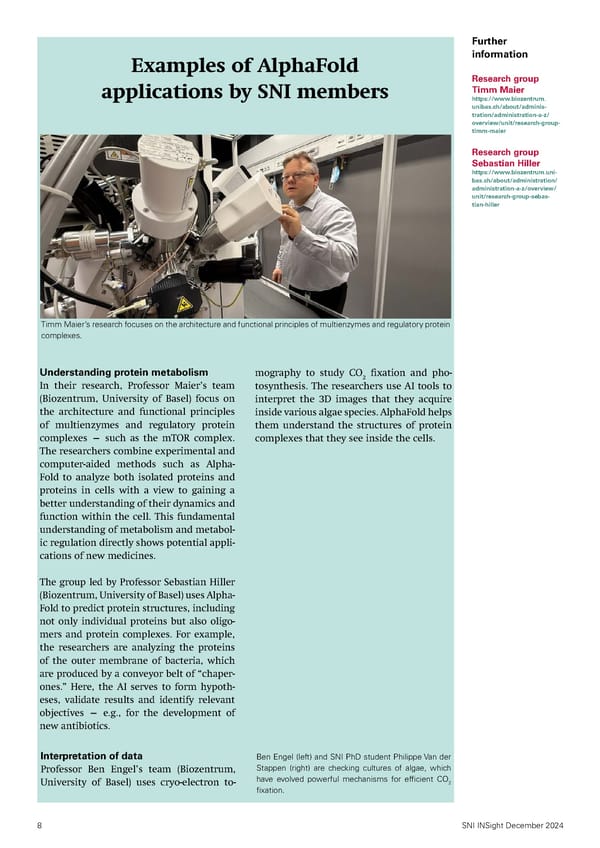
Further information Application in the development of artificial enzymes Research group The group led by Professor Thomas Ward (Department of Chemistry, University of Basel) Thomas Ward uses AlphaFold to support the development of arti昀椀cial enzymes which could serve as cat- https://ward.chemie.unibas. alysts in sustainable production processes for the chemical or pharmaceutical industry. For ch/en/ example, the researchers can use AlphaFold to validate designs obtained with other calcu- lation tools or by rational engineering. They can easily examine the expected structure of a new enzyme and compare it with design speci昀椀cations. Moreover, the predicted structures can help researchers understand the function of new enzymes and thereby identify parts of them that may need to be changed in order to improve their activity, for example. “Pre- viously, time-consuming and often di昀케cult experiments were necessary to determine the enzyme’s structure. With AlphaFold, a predicted structure with (often) su昀케cient accuracy can now be obtained within minutes to hours from simple web servers,” says Dr. Tobias Vornholt from Ward’s team. SNI doctoral student Damian Graf works in Thomas Ward’s team. SNI INSight December 2024 9
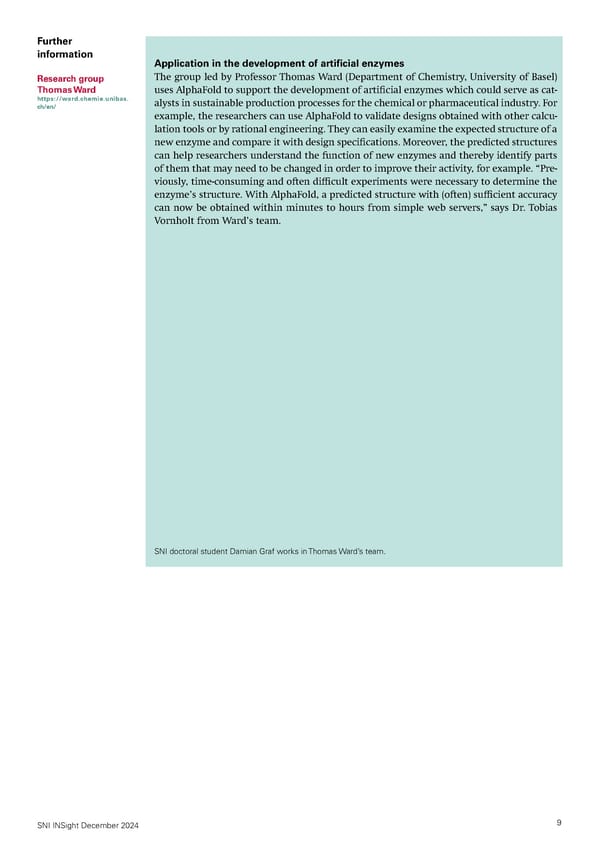
“Nano” in the environmental sciences Further information Examples of Nano-Argovia project DeePest nanotechnological applications https://nanoscience.unibas.ch/ en/forschung/applied-research/ argovia-projects-2019/ In the past, SNI publications on the nanosciences have primarily reported on topics in the 昀椀elds of nanophysics, nanochemistry, Nano-Argovia project NANOdePET nanobiology or nanomedicine — but there are also growing nano- https://nanoscience.unibas. ch/en/forschung/angewand- te-forschung/argovia-proj- science applications in the environmental sciences. In our strat- ects-2023-copy-1/ egy paper 2024-2034, we take account of this trend by including a plan for how “nano” can help tackle challenges in the environ- SNI INSight, we highlight issues mental sciences. In this edition of and questions from the environmental sciences that members of the SNI network have addressed in the past. We also present some interesting 昀椀elds within the environmental sciences where nano- technology plays a key role. These 昀椀elds could potentially bene昀椀t from innovative solutions developed by SNI members in the future. The environmental sciences are — like the that speci昀椀cally concentrate the pesticides nanosciences — a very broad area of exper- in a 昀椀ltration column. This column is also tise. Accordingly, the applications involving equipped with application-speci昀椀c sensors to nanoscience and nanotechnology are also detect glyphosate, atrazine and naphthalene, extremely varied. Fields where nanotech- for example. nology could make a valuable contribution include above all the analysis and reduction “As a next step, the project team of air and water pollution, the 昀椀xing of CO , 2 will improve the concentration the production and storage of renewable technique and combine it with energies, and the extraction/recovery of raw materials. Moreover, areas such as the some of the latest sensing tech- reduction of energy consumption by minia- nologies. This is intended to turization represent a signi昀椀cant bene昀椀t for broaden the spectrum of pesti- the environment, and one in which 昀椀ndings cides which our low-cost, portable from the nanosciences play a vital role. device can detect.” Detection of pesticides in drinking water Prof. Joris Pascal, Pesticides that contaminate drinking water FHNW School of Life Sciences are a major global problem. Even in very small amounts, they can be harmful to health. To detect these small amounts requires pre- cise analysis with sophisticated equipment — but this is not possible in many cases. In Filter membranes made of nanomaterials the Nano-Argovia project DeePest, research- To protect our environment, we need not only ers led by Professor Joris Pascal (University to detect pollutants and harmful substances of Applied Sciences and Arts Northwestern in drinking water but also to remove them. Switzerland) have developed a fully automat- Around the world, research is underway into ed method to detect even low concentrations various approaches to water 昀椀ltration using of various pesticides in drinking water. They puri昀椀cation techniques based on nanotech- investigated di昀昀erent nanostructured plastics nology. For several years, researchers from 10 SNI INSight December 2024
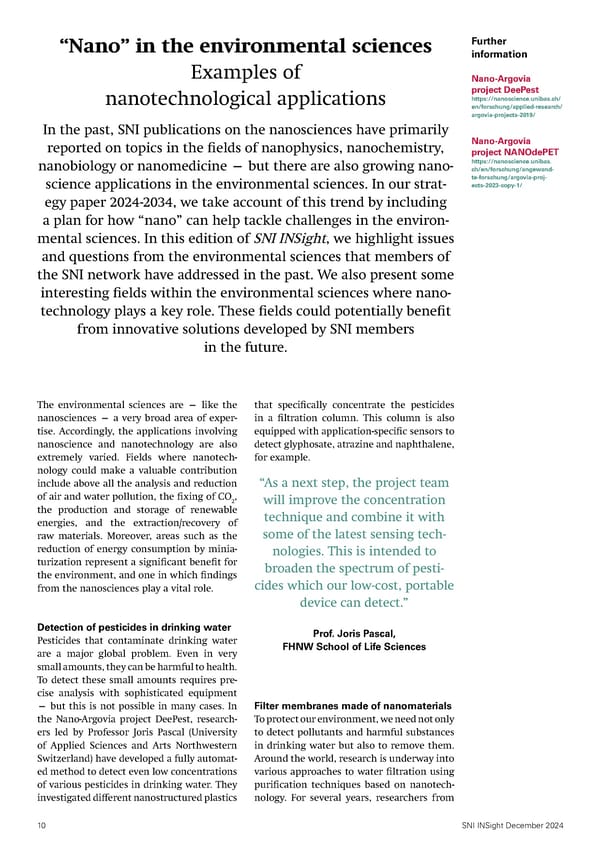
the Department of Chemistry of the University of Basel Using enzymes to combat plastic waste have been investigating whether polymer vesicles can be It is not only pesticides that pollute water. Indeed, various used as water 昀椀lters. plastics also present a problem for our environment. Poly- The group led by Professor Wolfgang Meier, who ethylene terephthalate (PET) is one of the most common sadly passed away in 2022, equipped vesicles with a bacte- plastics, with global production of over 55 million tons, rial water channel protein known as aquaporin Z (AqpZ) and is therefore a major component of plastic waste. and investigated their permeability to water and other Although methods exist for recycling PET, the substances. quality deteriorates with each recycling process, and The vesicles consist of a special polymer that is harmful degradation products are produced. In the Na- practically impermeable to water. When the AqpZ pro- no-Argovia project NANOdePET, led by Professor Patrick tein is incorporated into the membrane of the vesicles, Shaghaldian (FHNW School of Life Sciences), researchers however, the water permeability increases by a factor of are working on an improved degradation method. They up to 800. At the same time, certain substances such as are immobilizing PET-splitting enzymes (ester hydro- glucose, glycerol, salt and urea are retained completely — lases) on a silicon dioxide core using nanotechnological and all of this is achieved using a very low quantity of en- methods and stabilizing them with the help of so called ergy. These 昀椀ndings suggest that membranes containing arti昀椀cial chaperones. The researchers thus achieve high- AqpZ may be particularly e昀昀ective at water puri昀椀cation, er stability and a higher conversion rate than is the case as they 昀椀lter water selectively and are signi昀椀cantly more with dissolved enzymes. A shell of organic silicon dioxide permeable than conventional membranes. of controlled thickness protects the enzymes used from Extremely small pore sizes are also characteris- external in昀氀uences but allows the enzymatic cleavage of tic of other nanomaterials, such as carbon nanotubes, PET. In the current project, the interdisciplinary team is graphene oxide or nanoscale metal oxides, which can comparing the method they have developed with the re- therefore 昀椀lter out viruses, bacteria, heavy metals and cycling methods currently used and testing the method’s other chemicals e昀昀ectively. Compared with conventional suitability on an industrial scale. 昀椀lter systems, nano昀椀ltration o昀昀ers greater e昀케ciency and selectivity operating at the molecular level. This allows particularly thorough puri昀椀cation of drinking water — Cost-effective and efficient thin-film solar cells even in the case of heavy contamination — and could rep- E昀昀ectively countering climate change and its consequenc- resent a solution for improving global water supplies. es will call for new and innovative methods of energy Various lines of research (outside the SNI) have conversion. Perovskite solar cells (PSCs) are one of the shown that carbon nanotubes are not only suitable for the most promising developments in recent years and have elimination of viruses, bacteria and heavy metals but also attracted considerable interest given their cost-e昀昀ective have considerable potential for the desalination of water. manufacturing and high e昀케ciency. Immobilized and stabilized natural enzymes are coated with organic silicon dioxide in a controlled thickness. In this way, the enzymes are protected from external in昀氀uences, but can still degrade PET. The enzymes were subsequently colorized for aesthetic reasons (Image: S.A.Nazemi, FHNW). SNI INSight December 2024 11
Perovskites are materials with a special crys- mensional copper in order to maintain the Further tal structure that exhibit outstanding optical high performance and safety of the battery. information and electronic properties even at a coating By the end of the currently funded project, thickness of just a few hundred nanome- the researchers aim to develop a concept Nano-Argovia ters. Also of note are dye-sensitized solar for the industrial-scale production of the na- project BatCoat https://nanoscience.unibas.ch/ cells (DSSCs), in which light absorption is noscale layers. en/forschung/angewandte-for- optimized by combining dye molecules with schung/argovia-projekte-2024/ nanoparticles or nanowires. These systems Nano-Argovia are not only e昀케cient but also economical in “The BatCoat project addresses project MEGAnano- terms of resources, which makes them the the safety and energy density Power subject of intensive research. Nanotechnol- https://nanoscience.unibas.ch/ ogy plays a decisive role in this area by pro- challenges in fourth-generation en/forschung/applied-research/ argovia-projects-2018/ viding innovative materials and structures in lithium-metal solid-state order to further improve the e昀케ciency and batteries.” Research group pro昀椀tability of these solar cells. Markus Kalberer https://duw.unibas.ch/de/ Dr. Mario El Kazzi, forschungsgruppen/atmos- Paul Scherrer Institute PSI phaerenwissenschaften/ New storage solutions for renewable energies Institute for Sun, wind and water — as intermittent re- Ecopreneurship newable energy sources — are not always FHNW https://www.fhnw.ch/de/for- available in su昀케cient quantities. Further- Flow cell battery as an environmentally schung-und-dienstleistungen/ more, the electri昀椀cation of the transport lifesciences/ecopreneurship friendly energy storage device sector is crucial to accelerating climate neu- In the Nano-Argovia project MEGAnano- trality. Therefore, suitable storage solutions Power, researchers worked on the further are essential for the expansion of renewable development of an innovative 昀氀ow cell energies and the decarbonization of human battery (PowerCell®). The project sought to activities. develop an environmentally friendly and In the Nano-Argovia project BatCoat, cost-e昀昀ective energy storage device for large- researchers led by Dr. Mario El Kazzi (Paul scale applications. PowerCell® di昀昀ers from Scherrer Institute PSI) are investigating solu- conventional lithium-ion batteries by using tions for the next generation of lithium-met- solid electrolytes that are 昀椀nely dispersed al solid-state battery cells, which present a in the form of nanoparticles. The aim was promising alternative to conventional lithi- to reduce the size of these particles and in- um-ion battery cells. crease the solid electrolyte content with a Lithium-metal solid-state battery view to achieving greater energy density and cells have a higher energy density and are storage capacity. In addition, the researchers safer than the lithium-ion batteries currently have investigated how the electrodes and in use. In the newly developed lithium-metal membranes can be further optimized to im- solid-state batteries, the negative electrode prove the e昀케ciency of the electrochemical (anode) consists of a three-dimensional reactions with a focus on the use of environ- copper framework on which special, very mentally friendly and sustainable materials. thin functional layers are applied. These nanoscale layers help to ensure that lithium — which is only present in the cathode — Catalysis with nanoparticles deposits and dissolves evenly and repeatedly Renewable energies and better energy stor- on the anode. Unlike lithium-ion batteries, age devices alone will not be enough to these batteries use a solid electrolyte that tackle climate change. Around the world, re- conducts lithium ions, which can improve searchers are exploring di昀昀erent approaches the safety and stability of the batteries. to removing CO and other greenhouse gases The researchers in the BatCoat proj- 2 from the atmosphere. ect are now investigating how to ensure For example, the group led by that lithium deposits evenly on the copper Professor Markus Kalberer (Department of surface, allowing the battery to endure more Environmental Sciences, University of Ba- than 500 charge and discharge cycles while sel) is investigating whether nanoparticles retaining its high capacity. At the same time, are suitable catalysts for breaking down CO the aim is to prevent lithium from reacting 2 when excited by light. The use of nanopar- with the solid electrolyte. In addition, the ticles is particularly promising because they team is exploring the advantages of three-di- 12 SNI INSight December 2024
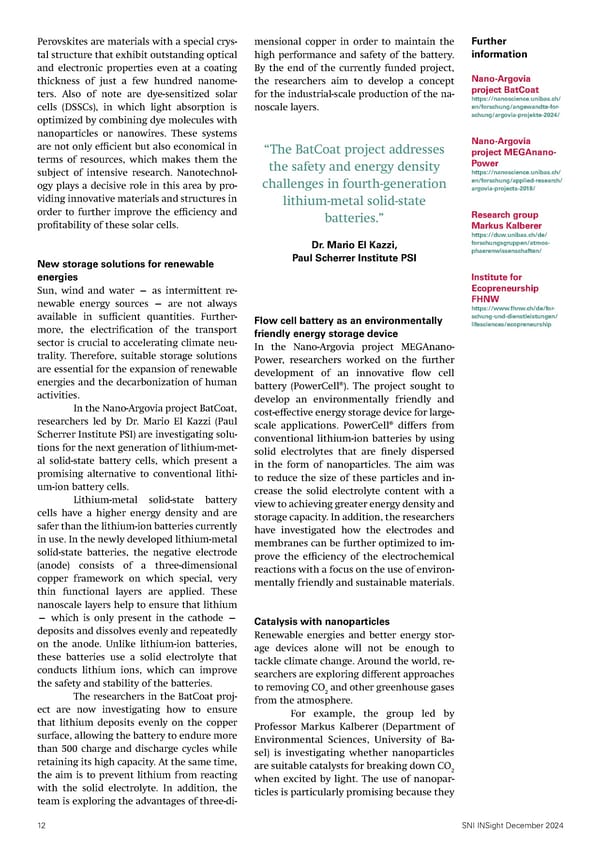
have a very large surface area relative to their volume and exhibit numerous surface defects that further improve the e昀케ciency of conversion. For these analyses, the researchers 昀椀rst produce titanium dioxide nanoparticles by aerosolization and then cover them with gold nanoparticles in a spark gen- erator. The combination of titanium dioxide and gold nanoparticles can extend the useful spectrum from UV to visible light, allowing researchers to initiate the cat- alytic breakdown of CO with sunlight and improve the 2 e昀케ciency. Before reaching the application stage, it will be necessary to characterize the nanoparticles accurately in order to better understand their properties. For such analyses, the Nano Imaging Lab team is a key point of contact when it comes to investigating the morphology Transmission electron microscope image of titanium dioxide (large, light and the ratio of titanium dioxide and gold nanoparticles spots) and gold nanoparticles (small, darker spots). (Image: B. Gfeller, with high-resolution electron microscope images. Department of Environmental Sciences, University of Basel) “Nanoparticles can help to mitigate climate change because their huge surface area and unique defects make them highly e昀케cient catalysts that can convert CO into energy-rich organic compounds 2 such as methane (natural gas) with the help of sunlight.” Benjamin Gfeller, doctoral researcher, Kalberer Group Department of Environmental Sciences, University of Basel X-ray spectroscopy. Titanium dioxide nanoparticles are shown in blue, and gold nanoparticles are shown in green. (Image: B. Gfeller, Depart- ment of Environmental Sciences, University of Basel) Extraction and recovery of raw materials At the Institute for Ecopreneurship at the FHNW School of view to separating and concentrating metals from acidic Life Sciences, former nanoscience student Meret Amrein waste streams. To this end, she produces “layer-by-layer” is researching nano昀椀ltration membranes for the reuse of (LbL) membranes by applying charged polyelectrolyte valuable metals in solar cells in a group led by Dr. Markus layers to a porous support substrate. These membranes Lenz. The recovery of these and other raw materials rep- have high permeability and require signi昀椀cantly lower resents a key step on the journey toward planned climate operating pressures than conventional nano昀椀ltration neutrality with a view to covering supply and demand. membranes — and can therefore be operated with con- Meret Amrein is working in a team that focuses siderably lower power consumption. Overall, this allows on the recycling of next-generation thin-昀椀lm solar cells, for a signi昀椀cant reduction in chemical and energy con- whose production is set to increase over coming years. sumption for the reprocessing of metals from solar cells. These cells often contain metals such as silver and indium. In recycling, metals are usually separated and puri昀椀ed Further nano applications in the environmental using hydrometallurgy (extraction using aqueous solu- sciences tions). This process often consumes huge quantities of Around the world, researchers are investigating many chemicals and is associated with negative environmental other nanotechnology-based approaches in the environ- impacts and health risks. In this context, chemical-free mental sciences. For example, nanotechnology plays a key nano昀椀ltration — a pressure-driven technique for treating role in the monitoring of pollutants, in air quality man- aqueous solutions using pore sizes of less than 2 nanome- agement or in soil treatment. Accordingly, nanosensors ters — can o昀昀er a promising alternative or supplement to are used to monitor various substances in air, water and classical hydrometallurgy. soil. Nanocatalysts and photocatalysis are used to break In her doctoral dissertation, Meret Amrein is in- down airborne pollutants such as nitrogen oxides. In soil vestigating tailor-made nano昀椀ltration membranes with a treatment, iron nanoparticles support the breakdown of SNI INSight December 2024 13
accumulating in higher organisms, includ- Further ing humans, via the food chain. Accordingly, information further research is needed into all of these e昀昀ects. NFP 64 https://www.snf.ch/de/ vbdmYGLawbfYKmOY/ Basic research is also relevant seite/fokusForschung/natio- nale-forschungsprogramme/ to environmental sciences nfp64-chancen-risiken-nanoma- It is not only applied nanotechnology research terialien projects that play a role in the environmental sciences. In basic research, too, researchers are developing insights that could be rele- vant to our environment in the future. For example, the team led by Pro- fessor Ernst Meyer (Department of Physics, University of Basel) is investigating the fundamentals of friction on the nanometer scale. If we could use this research to reduce friction in electronic devices or in transport, Meret Amrein investigates nano昀椀ltration membranes for example, it may be possible to improve with a view to reducing the chemical and energy con- energy e昀케ciency. sumption required in reprocessing metals from solar It is vital for the future of our cells. (Image: N. Zonvi, FHNW) planet that we also gain a detailed understand- ing of photosynthesis and the organisms that remove most of the CO that is produced from organic pollutants in soil and groundwater. 2 the atmosphere again and convert it into or- Nanotechnology also plays a role in nanofer- ganic matter. For example, the team led by tilizers and nanopesticides and can therefore Professor Ben Engel (Biozentrum, University contribute to greater sustainability in agri- of Basel) makes a key contribution to this with culture. its analyses of the molecular architecture and evolution of photosynthetic organelles. Toxicity of nanoparticles in the environment “There are many further It is impossible to talk about nanosciences examples of interfaces between and the environment without mentioning the environmental impact of nanoparticles. the nano and environmental There are currently no ongoing projects in sciences. We hope that, with the the SNI network that deal with these issues. research supported by the SNI, In Switzerland, they were the subject of the National Research Programme “Oppor- we can contribute to future appli- tunities and Risks of Nanomaterials” (NFP cations of nanotechnology for 64), which was carried out between 2010 the bene昀椀t of the environment.” and 2015. As part of the program, scientists sought to gain a better understanding of the opportunities and potential risks of products Prof. Martino Poggio, SNI director based on arti昀椀cial nanoparticles. Worldwide, the environmental tox- icity of nanoparticles is a matter of growing concern, as the high reactivity of these tiny particles allows them to interfere with sensi- tive ecosystems. Certain nanomaterials, such as silver or titanium dioxide nanoparticles, are demonstrably toxic to aquatic organisms. In soils, nanoparticles can also be detrimen- tal to microorganisms, plants and animals and thus interfere with the ecological bal- ance. Some nanoparticles are poorly biode- gradable and can therefore cause long-term environmental damage. There is also the risk that the particles will cause problems by 14 SNI INSight December 2024
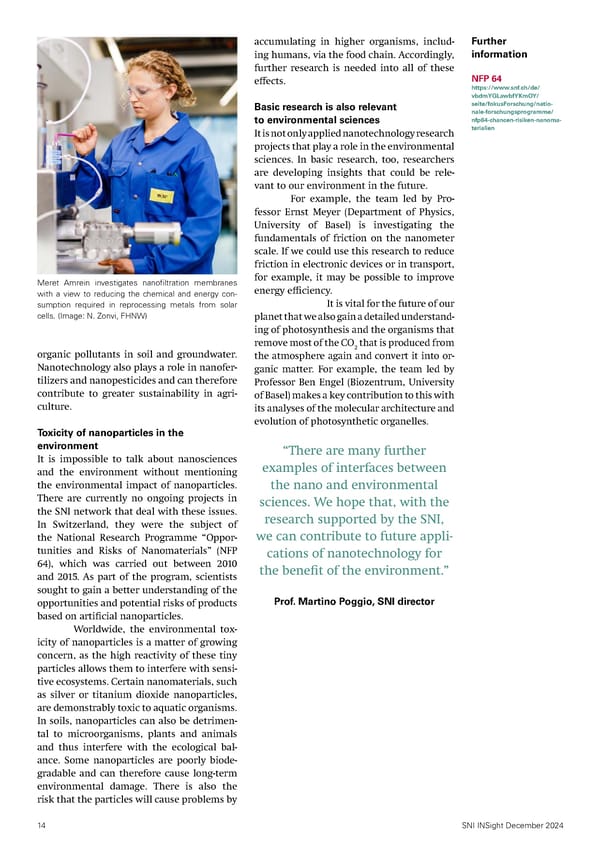
Nano Image Award Congratulations to the winners and many thanks to everyone who participated! SNI INSight December 2024 15
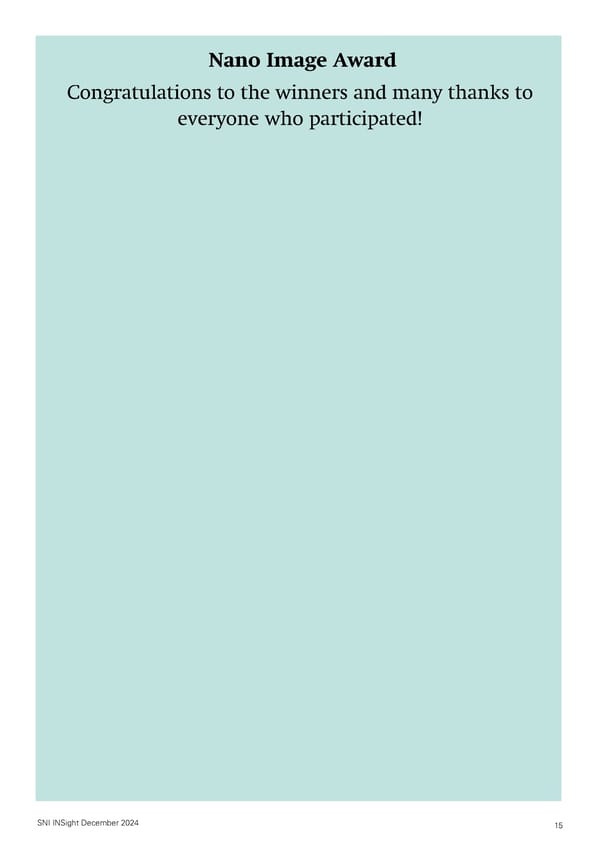
Guest article by Gregory Zaugg Master’s thesis at the Jet Propulsion Laboratory (CA, USA) The time I was able to spend at the Jet Propulsion Laboratory (JPL) is something that will stay with me forever. From the open-mindedness of the Americans and the rooms where history was written to the endless bureaucracy, it was an incredible experience — and one for which I’m extremely grateful. Arrival and 昀椀rst day at JPL: the obligatory photo with the big JPL logo Sur昀椀ng trip with the interns: As a hobby surfer, I simply had to give the that greets you at the entrance every morning. other interns a taste of the real California vibes. After an intensive week at JPL, what better way to relax than by driving down the Paci昀椀c Coast Highway with the windows down and surfboards on the roof to go and ride a few waves at Sunset Beach in the “Endless Summer” of LA. Most of all, I was amazed at how people who are or were wood and 昀椀lms like “The Martian” suggest, only the mis- involved in major missions such as Mars 2020 (Persever- sion-critical parts of JPL are “high-tech.” This made it even ance & Ingenuity) or Europa Clipper took the time to more impressive to see the groundbreaking research and meet up and chat with an “ordinary” intern like me. I had development being carried out there. the chance to sit down for a co昀昀ee with lead scientists and I had the privilege of working on research into head engineers to discuss the challenges of performing the origins of life in a wonderful group known as the Raman spectroscopy on Mars, for example. The wealth Origins and Habitability Lab. Speci昀椀cally, the lab is con- of knowledge and contacts that various people happily cerned with hydrothermal vent systems and the theory shared with me is simply invaluable. that these are where the 昀椀rst complex biomolecules (e.g., JPL itself has a special status among NASA’s labo- RNA, amino acids and ATP/ADP) may have been formed. ratories. It is managed externally and also co昀椀nanced for As these systems are found on the seabed, however, and NASA by Caltech, resulting in a close relationship with the are therefore not particularly easy to reach or research, a next generation of engineers and scientists. I think this lot of work goes into developing laboratory simulations. is one of the reasons why interns like me feel so valued This was also the subject of my project. and involved. The interns themselves were an incredibly So-called “chemical gardens” — structures that friendly, active and diverse group of people from all over self-assemble when contrasting chemicals mix in a cer- the world, and this made both my time at the lab and the tain way — have long served as promising analogs for task of developing new contacts hugely enjoyable. vent systems. In my research, we investigated how vent Despite all of the splendor, it was interesting to morphology is in昀氀uenced by the composition and con- see that JPL is nevertheless a state research institute that centration of the starting chemicals. operates with limited funding. Contrary to what Holly- SNI INSight December 2024 16
Mission control room: During missions and key events, this seat is usu- The Mars Automated Giant Gizmo for Integrated Engineering (MAGGIE) ally 昀椀lled by those at the top of the chain of command. is a perfect double of the Curiosity Rover (without the radioisotope ther- moelectric generator, for obvious reasons) and helps to get the genuine rover out of critical situations. These situations are reconstructed in the “Mars yard” next door, and trial and error is then used to develop com- mand sequences that can get the real rover operating normally again. “Overall, I’m extremely grateful for this experience and will always look back fondly on my time at JPL. And if everything goes well, I’ll be able to build on the knowledge and contacts I gained to enhance my professional career.” Gergory Zaugg, former nanoscience student at the University of Basel Jet Propulsion Laboratory https://www.jpl.nasa.gov How far will your mug travel? At the SNI Annual Event in September, all SNI members received a mug printed with the SNI’s four key principles: focus, collaboration, adaptati- on and impact. We invite you to take your mug on trips and send us a photo — whether it’s a holiday, a meeting or a visit to another research group. All entrants have the chance to win one of three CHF 100 travel vouchers from SBB in a ra昀툀e that will be held in September 2025. We look forward to receiving your photos and seeing where you and your SNI mugs have got to. Please send the photos (or a request for an SNI mug — we still have a few left) to: [email protected]. These two mugs made it to the NanoTec Apéro and to the roof terrace of the Department of Physics at the University of Basel? Where will your SNI mug accompany you? SNI INSight December 2024 17
Guest article by Alexa Dani Master’s thesis in Groningen (NL) My placement at the University Medical Center Groningen (UMCG) in the Netherlands was an incredible experience — both professionally and for me on a personal level. I received a very warm welcome to Professor Hélder Almeida Santos’ research group at the Department of Biomaterials & Biomedical Technology (BBT). There, I investigated the synthesis and potential of metal-organic framework nanoparticles for biomedical applications in greater detail. I learned valuable methods from chemistry, materials science and biology and had the chance to explore a fascinating and previously undiscovered area of science in collaboration with my supervisors. The aim of my master’s thesis was to synthesize wide-rang- ing nanoparticles with a metal-organic framework (MOF NPs), which have received growing attention over recent years due to their porosity and excellent modi昀椀cability. The particles were then to be tested on macrophages — vi- tal immune cells that can switch into a pro- or anti-in昀氀am- matory state depending on external stimuli. In昀氀uencing this “polarization” from the outside could represent an innovative treatment approach in the event of immune dysfunction. The key aim of my master’s thesis was there- fore to test the e昀昀ect of MOF NPs with di昀昀erent compo- sitions, crystallinities and shapes on the polarization of macrophages. A further objective was to integrate these MOF NPs into polymer-based dissolvable microneedle (dMN) patches, which are being developed as a painless, transdermal means of drug administration. The project fully met my de昀椀nition of “medical nanosciences,” as it combined aspects of chemistry, mate- rials science and biology in a biomedical application and therefore required interdisciplinary thinking. It was also a special experience to collaborate on a project that had been the subject of very little research so far and that was Almost endless 昀椀elds of tulips near the Dollard. also new to my supervisors. This a昀昀orded me consider- able in昀氀uence over the project. and e昀昀ectiveness of my system using a series of analytical In the 昀椀rst phase of my master’s thesis, I focused techniques. on the synthesis and characterization of the MOF NPs, Overall, we succeeded in synthesizing MOF working with experts to produce electron microscope im- nanoparticles with our desired physico-chemical proper- ages and evaluate the crystal structure of the nanoparti- ties for potential biomedical applications. Moreover, we cles. I also evaluated the size and surface properties of the demonstrated that these nanoparticles can be incorporat- MOF NPs using dispersion-based particle characterization ed into the patches. methods. The second phase involved the production of During my time at the UMCG, I felt very welcome transdermal patches, which helped me deepen my under- and appreciated in Professor Santos’ research group and at standing of biomaterials. Above all, I learned a lot about BBT. I particularly valued the research group’s collabora- the strict requirements that these materials have to meet tions both within and beyond the department, which will for biomedical applications. Lastly, I worked with cell hopefully also lead to future partnerships between the cultures — particularly macrophages — to test the safety Swiss Nanoscience Institute and the UMCG. The weekly SNI INSight December 2024 18
Further information Biomaterials & Bio- medical Technology (BBT) at University Center Groningen https://umcgresearch.org/w/ biomaterials-and-biomedi- cal-technology Transmission electron micrographs of nanoparticles with Microscopic image of a polymer microneedle patch. This a metal-organic framework. patch has a size of about 1x1 cm with 100 needles. BBT meetings were an opportunity for me to “I’m grateful to the Swiss expand my knowledge in various 昀椀elds, such Nanoscience Institute and as nanomedical formulations for the treat- Professor Santos for this amazing ment of cancer and cardiovascular diseases, as well as new technologies in regenerative opportunity. As well as gaining medicine. For me, one highlight was a talk knowledge and practical experi- by Professor Elisabeth Bik on the integrity of ence, I discovered new avenues of research and the associated challenges when it comes to scienti昀椀c publications. professional and personal devel- Groningen is a proper student city opment — and had a great time and often only really wakes up at 11 pm — so in Groningen, both inside and there was plenty to discover with my col- leagues. From a culinary perspective, I par- outside the laboratory.” ticularly remember the sweet stroopwafels. Alexa Dani, former nanoscience student, University of Basel Almost endless 昀椀elds of tulips near the Dollard. Day trip with Professor Santos’ research group with golf followed by a barbecue. SNI INSight December 2024 19
Funding of SNI members Further information In recent months, numerous SNI members have been awarded Swiss National Science Foundation grants for research projects from wide-ranging sources. Here, (SNSF) https://www.snf.ch/en with brief descriptions of the various projects, we provide Project description insights into the diverse scienti昀椀c questions addressed within our Marek Basler https://data.snf.ch/grants/ network. Could one of these topics inspire a future collaboration? grant/10000935 Research group Marek Basler https://www.biozentrum.uni- bas.ch/about/administration/ administration-a-z/overview/ unit/research-group-marek- Analysis of a complex secretion system Imaging the human brain with its 86 basler Professor Marek Basler (Biozentrum, Univer- billion cells Project description sity of Basel) and his team are investigating In a project funded by the Swiss National Bert Müller https://data.snf.ch/grants/ the assembly of the type 6 secretion system Science Foundation for four years, the team grant/10000247%20 (T6SS) found in species such as Pseudomonas led by Professor Bert Müller (Department Research group aeruginosa and Acinetobacter baylyi, for of Biomedical Engineering, University of Bert Müller example. The complex mechanism of T6SS Basel) plans to image all cells of the human https://dbe.unibas.ch/ enables bacteria to inject toxins into other brain without dissecting it. The researchers en/research/biomechan- ics-and-biomaterials/biomateri- cells and thus to prevail over competing mi- have already succeeded in doing so with als-science-center/ croorganisms and hosts. the brain of a mouse, but a human brain Interview with In September 2024, Basler’s team is 3,000 times bigger and during the proj- Bert Müller launched a project that will be funded by the ect volumes of data must be stored and https://spie.org/news/ heady-matters-on-the-cusp-of- Swiss National Science Foundation for four processed running into the petabytes (1 x-ray-tomographic-mapping-of- years in order to analyze the individual steps petabyte is equal to 1,000 terabytes). The the-human-brain-and-its-1011- cells#_=_ in T6SS assembly and changes in protein-pro- researchers will rise to this challenge from tein interaction. Based on their analyses, the February 2025 onward. Their aim is also to researchers plan to generate a precise model 昀椀nd out how such huge volumes of data can of the secretion system and its intermediate be made accessible to the scienti昀椀c com- assembly steps. This will help to gain a better munity in order to 昀椀nally understand the understanding of the behavior and interac- anatomy and functionality of healthy and tions of human pathogens during an infec- diseased brains in detail. tion. Marek Basler’s team is investigating the complex mech- anism of the T6SS secretion system, which enables bacteria to inject toxins into other cells and thus to pre- vail over competing microorganisms and hosts. (Image: Biozentrum, University of Basel) Researchers working with Bert Müller have already im- aged the cells of a mouse brain without the need for dissection. Now, they are planning to image the 86 billion cells of the human brain. (Image: Department of Biomed- ical Engineering, University of Basel) 20 SNI INSight December 2024
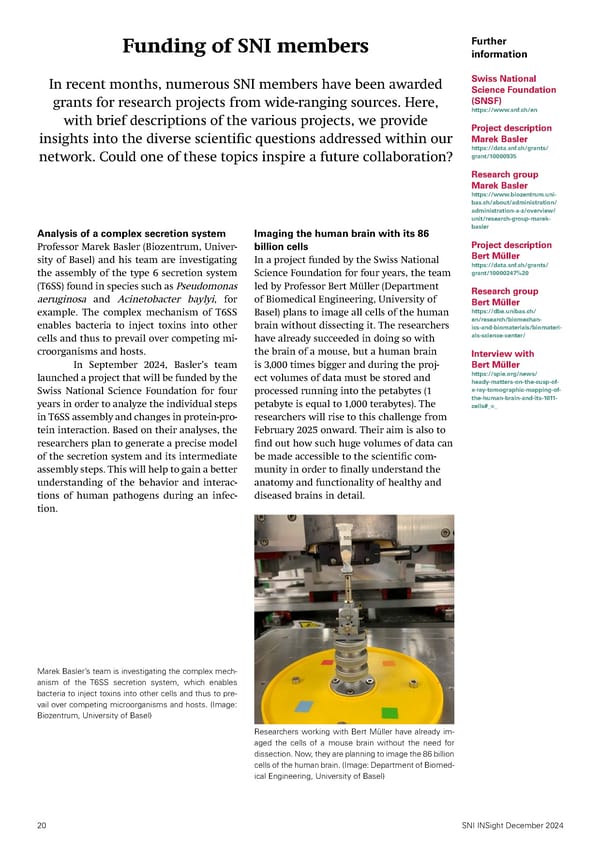
Further A better understanding of Regulation of cell metabolism information photosynthesis As part of an SNSF project in collaboration The team led by Professor Benjamin Engel with researchers from the University of Kiev Swiss National (Biozentrum, University of Basel) is investi- (Ukraine), Professor Timm Maier (Biozentrum, Science Foundation gating thylakoid membranes, which play University of Basel) is investigating a special (SNSF) an important role in photosynthesis. In the group of proteins (Rag proteins) that play an https://www.snf.ch/en chloroplasts of plants and algae, the protein elementary role in the regulation of cell me- Project description complexes that control the light-dependent tabolism. The main function of Rag proteins Ben Engel reactions of photosynthesis are embedded is to control the mTOR complex. Rag proteins https://data.snf.ch/grants/ grant/10001398 within these complex thylakoid networks. In help mTOR to determine whether su昀케cient Research group an SNSF-funded project in collaboration with nutrients such as amino acids are available in Ben Engel the University of California, the researchers the cell to trigger growth processes. https://www.biozentrum.uni- aim to develop a mechanistic model that In the project, which has been ap- bas.ch/about/administration/ administration-a-z/overview/ shows how thylakoid membranes are as- proved for three years, the focus is primarily unit/research-group-ben-engel sembled and how they form their intricate on low-molecular compounds that bind to Project description architecture, which enables photosynthetic Rag proteins. In fundamental research, they Timm Maier proteins to convert sunlight into life. The re- can serve as important tools for investigat- https://data.snf.ch/grants/ grant/224771 searchers will use a cellular system in which ing and analyzing the diverse roles of Rag Research group photosynthesis can be switched on and o昀昀 proteins. In addition, such compounds with Timm Maier and will combine this with cryo-electron a selective functional e昀昀ect on Rag proteins https://www.biozentrum. tomography. This will allow them to track are an important starting point for the devel- unibas.ch/about/adminis- thylakoid membrane development at molec- opment of new drug candidates and poten- tration/administration-a-z/ overview/unit/research-group- ular resolution. tial therapies – especially for the treatment timm-maier of cancer. Project description Markus Kalberer https://data.snf.ch/grants/ grant/10001153 Toxicity of particulate matter and Research group fuel emissions Markus Kalberer The group of Professor Markus Kalberer (De- https://duw.unibas.ch/de/ partment of Environmental Sciences, Univer- forschungsgruppen/atmos- sity of Basel) is investigating the toxicity of phaerenwissenschaften/ particulate matter, in particular the oxidative potential, which is a good approximation for the toxicity of aerosols. In a new SNSF proj- ect, the researchers want to gain a better un- derstanding of the molecular basis of these processes and develop a new device that can measure not only the toxicity of particles, but also that of the gas phase. The Kalberer team will also measure aerosols (brake wear and desert dust) to determine their toxicity. In another Horizon Europe project, Markus Kalberer plans to determine the oxi- dative potential of emissions from new types of fuels that produce no or very little CO 2 when burned (low- or zero-carbon fuels) in order to gain a better understanding of the toxicity of these fuels. Evolution of artificial enzymes Professor Thomas Ward’s group (Depart- ment of Chemistry, University of Basel) has SNI doctoral student Philippe Van der Stappen together launched a project that seeks to optimize with Ben Engel are using advanced cryo-electron tomog- arti昀椀cial catalysts in collaboration with the raphy to look at the protein machines that perform CO University of California, Irvine. The research- 2 ers are working on the hypothesis that natu- 昀椀xation inside algae cells. ral enzymes in modern organisms have been SNI INSight December 2024 21
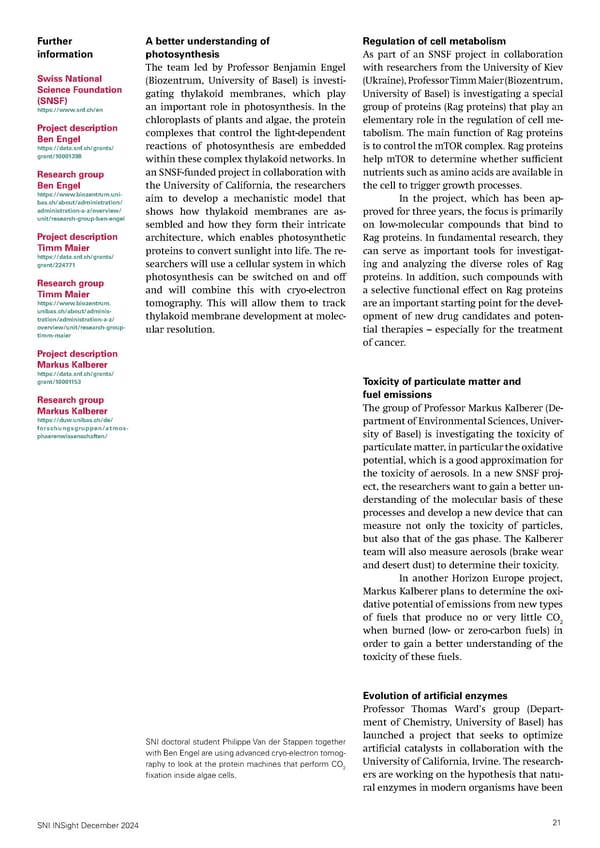
optimized over a long evolutionary process, that cannot be interconverted. As part of the Further mainly by the formation of complex amino project, this phenomenon will be investigat- information acid networks. ed by Sparr’s team. The teams from Basel and Irvine have Swiss National therefore developed a system (OrthoRep) Science Foundation that can mimic thousands of years of evolu- Interactions on surfaces of 2D materials (SNSF) https://www.snf.ch/en tion in the laboratory in just a few weeks. The team led by Professor Ernst Meyer (De- Project description Now, the researchers will study the e昀昀ect of partment of Physics, University of Basel) is Tom Ward thousands of mutations on two arti昀椀cial me- using its expertise in scanning probe micros- https://data.snf.ch/grants/ talloenzymes (ArMs) whose genetic informa- copy to investigate localized interactions on grant/10000664 tion has been integrated into yeast cells. The two-dimensional materials. In this four-year Research group metalloenzymes mimic primitive enzymes project of the Swiss National Science Founda- Tom Ward in which the catalyzed reaction depends on a tion, the researchers will not only image the https://ward.chemie.unibas.ch/ cofactor attached to a protein. In the project, various two-dimensional materials and ana- Project description which will be funded for four years by the lyze them spectroscopically, but will also use Christof Sparr SNSF, the scientists will investigate whether scanning probe microscopes to make chem- https://data.snf.ch/grants/ the properties of the metalloenzyme can be ical changes to the surface. They also plan grant/10001653 optimized through evolution in the amino to analyze completely novel combinations Research group acid network. of various materials that exhibit interesting Christof Sparr quantum mechanical properties. In another https://sparr.chemie.unibas. ch/en/ of the project’s focuses, the researchers will Project description investigate friction and contact forces of 2D Ernst Meyer materials. https://data.snf.ch/grants/ grant/10001697 Research group Ernst Meyer https://nanolino.physik.unibas. ch/en/ SNI PhD student Damian Graf is part of Thomas Ward’s team, which will seek to optimize arti昀椀cial catalysts in the new SNSF project. Ernst Meyer’s team uses scanning probe microscopes Triple bond with restricted rotation to investigate local interactions on two-dimensional ma- The group led by Professor Christof Sparr terials. (Department of Chemistry, University of Basel) is working on the development of Optimized fabrication and performance of new synthetic methods and the synthesis quantum sensors of unique molecular structures. In a Swiss As part of the federal government’s Swiss National Science Foundation project over Quantum Initiative, the team led by Profes- the next four years, the researchers will in- sor Patrick Maletinsky (Department of Phys- vestigate “alkyne atropisomers” — carbon ics, University of Basel) will begin a four-year compounds with triple bonds (alkynes) in project in January 2025. The researchers will which each of the carbon atoms of the triple optimize the nanofabrication of existing bond is also bonded to a bulky group. These quantum sensors based on diamonds with large groups are located close to one another nitrogen-vacancy centers in order to make despite the lack of space, leading to restricted them accessible to a wider range of users in rotation within the molecule. Under certain research and industry. Moreover, the team conditions, this gives rise to various isomers will further improve the performance of the 22 SNI INSight December 2024
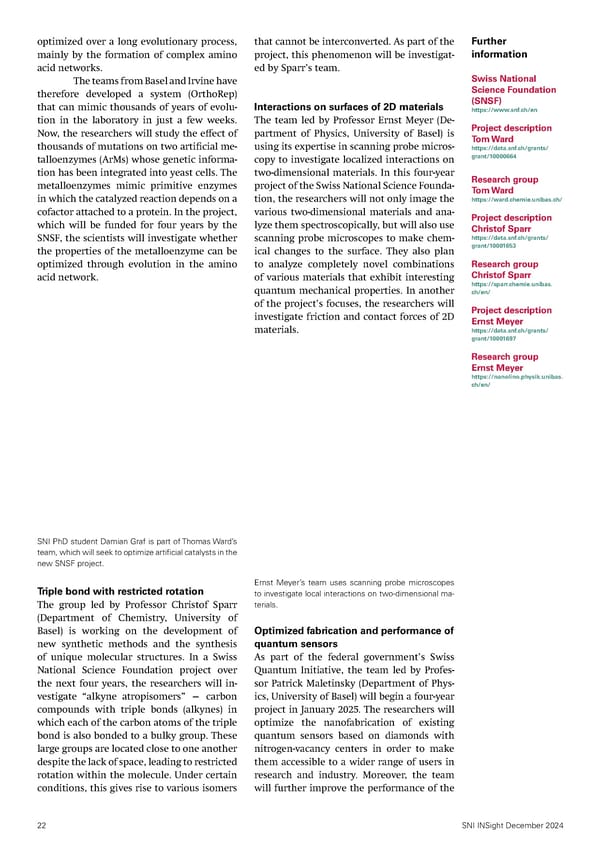
Further quantum sensors in terms of their spatial res- Materials and Devices for Metrology), devel- information olution, sensitivity and functionality. oped as part of the European Metrology Part- nership. The aim of the project is to research Swiss Quantum Call and develop materials and devices that use 2024 Control over quantum processes thanks the quantum anomalous Hall e昀昀ect (QAHE) https://www.snf.ch/media/de/ p5ohquN28RM7xgVr/swiss- to coherent feedback to realize a primary standard for electrical quantum-call-2024-granted- As part of the Swiss Quantum Call 2024 of the resistance. Compared to current methods projects.pdf Swiss Quantum Initiative, the team led by based on the quantum Hall e昀昀ect, the QAHE Research group Professor Philipp Treutlein (Department of o昀昀ers the advantage of functioning under less Patrick Maletinsky Physics, University of Basel) has also received extreme conditions, such as lower magnetic https://quantum-sensing. the go-ahead for a project that will be funded 昀椀elds or higher temperatures. This could physik.unibas.ch/ for four years. Launched in September, the make using quantum e昀昀ects for electrical Research group project aims to control quantum processes measurements and the de昀椀nition of SI units Philipp Treutlein using a coherent feedback loop, whereby more accessible. https://atom.physik.unibas.ch/ quantum signals are processed and returned The Poggio Lab will contribute its QuAHMET without a measurement taking place. This expertise in low-temperature scanning probe https://sites.google.com/inrim. is bene昀椀cial because in quantum systems, microscopy to support project partners in it/quahmet/home?authuser=0 each measurement constitutes an interfer- the design and fabrication of magnetically Research group ing factor that alters the quantum state. By doped topological insulators, required for Martino Poggio bypassing the measurement, the researchers the QAHE, and to investigate the electronic, https://poggiolab.unibas.ch hope to open up new applications in quan- magnetic and structural properties of these tum technology. materials. In further modules, various in- ternational project partners are working to develop precise measurement methods for Using quantum effects for metrology QAHE-based devices and to promote the ap- Professor Martino Poggio’s group is partic- plication of these technologies in areas such ipating in the European research project as spintronics and topological quantum com- QuAHMET (Quantum Anomalous Hall E昀昀ect puting. Floris Braakman from Martino Poggio’s team is contributing his experience in the 昀椀eld of low-temperature scanning probe microscopy to the QuAHMET project. SNI INSight December 2024 23
SNI startup workshop Further information “From Lab to Startup” SNI PhD School https://nanoscience.unibas.ch/ en/forschung/phd-programm/ Doctoral students from the SNI PhD School generally work on Innovation Office questions of basic research. Sometimes, however, the prospect Universität Basel https://www.unibas.ch/en/ of an innovative application is not that far removed from their Innovation/ work. In mid-October, seven SNI doctoral students received expert guidance as they gained extensive insights into the world of founding a startup. This experience brought the process of founding a business within reach for the young researchers, who learned about the 昀椀rst key steps in launching their own startup and displayed great energy and enthusiasm as they developed business ideas of their own. Accordingly, the “From Lab to Start- up” workshop, which follows a new concept and will now be held every year as part of the SNI PhD School, was a complete success. For most doctoral researchers of the nano- Intensive days with excellent results sciences, founding a startup is not exactly In collaboration with Mauricio Campos, who top of their list of options after completing owns a consultancy 昀椀rm, Pekonen led the their doctorate. To highlight the possibility 昀椀rst installment of the workshop, which was of founding a business and provide young re- attended by seven doctoral students from the searchers with an introduction into the req- SNI PhD School and Andreas Baumgartner uisite knowledge and tools, the coordinator on 16–17 October. Over two morning ses- of the SNI PhD School, Dr. Andreas Baumgart- sions, the participants learned a great deal ner, worked with Anna-Elina Pekonen from about the mindset and skills needed to turn the Innovation O昀케ce of the University of research 昀椀ndings into a successful startup. Basel to design a new concept for the short “It’s imperative that although this includes workshop “From Lab to Startup” for SNI doc- a certain willingness to take risks, the 昀氀ip toral students. side is that there’s no shame in failure and Seven SNI doctoral students showed a great deal of energy and enthusiasm as they attended the new “From Lab to Startup” course, developed in collaboration with the Innovation Of昀椀ce of the University of Basel. 24 SNI INSight December 2024
“It was great to see how the participants “Over the two days, I increasingly lost developed their projects in a very short track of which projects were actually going time period of just 1.5 days, resulting in an to be implemented and which had been impressive outcome.” ‘invented’ by our doctoral students.” Anna-Elina Pekonen, Innovation Office, Dr. Andreas Baumgartner, coordinator of University of Basel the SNI PhD School it’s not the end of your career — indeed, the opposite and the individual support from Pekonen and Campos, might be the case,” explains Pekonen. Moreover, the two inspired impressive results from all participants at the successful company founders Adrian Bertschi and Gilbert end of the two-day course. Elizaveta Maksimova from Koch talked live about ups and down at their companies, the team of Professor Jonathan de Roo (Department of providing participants with vivid and speci昀椀c insights Chemistry) was the most convincing in her closing pitch. into the subject matter. In the two afternoon sessions, With a clear presentation and a competent demeanor, the workshop then centered around the development of she won over the jury — consisting of Pekonen, Campos each participant’s own business idea and the preparation and Baumgartner — with her startup idea and secured of a closing pitch that could win over potential investors. the prize for the best pitch. In preparation for the workshop, all participants With this new course, the SNI promises above had already developed a business idea as well as an initial all that budding researchers will give thought to alter- version of their presentation — in most cases, based on native career pathways and will increasingly evaluate their own research in wide-ranging disciplines. The con- the applicability of their scienti昀椀c 昀椀ndings, learning tent and guiding structures conveyed in the workshop, to recognize how these 昀椀ndings could help overcome future challenges. Elizaveta Maksimova won over the jury (Anna-Elina Pekonen, Mauricio Campos and Andreas Baumgartner (not in the picture)) with a pitch for her business idea. (Image: A. Baumgartner) “I further developed the academic ideas from my dissertation project and felt very comfortable thinking about the next step to founding a startup. The SNI Rhetoric Workshop I attended last year really helped me deliver a convincing It was an intensive two days in which doctoral students from the SNI PhD presentation.” School gained extensive insights into the world of founding a startup. Elizaveta Maksimova, SNI doctoral student at the Department of Chemistry of the University of Basel and winner of the pitching competition SNI INSight December 2024 25
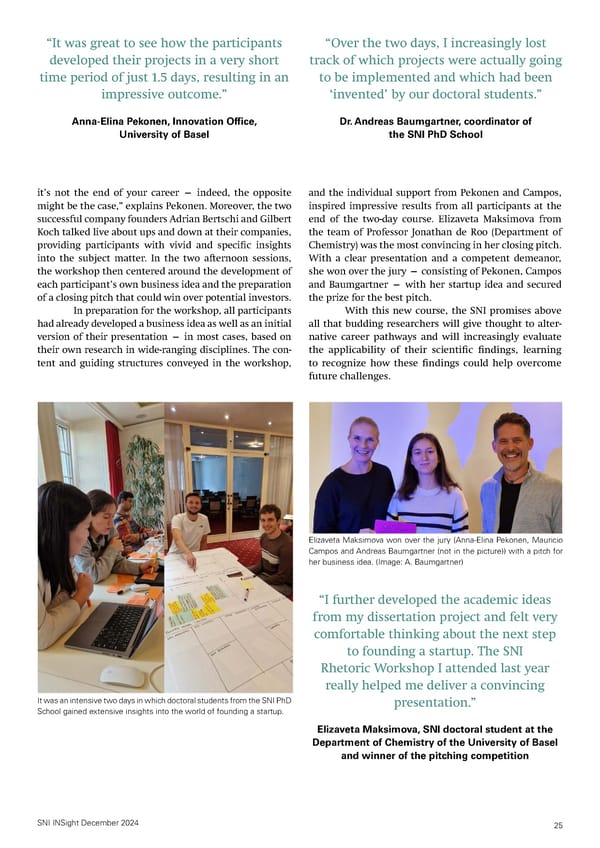
Awards and honors Ruzicka Prize for Murielle Delley Professor Murielle Delley (Department of Chemistry, University of Basel) has been awarded the Ruzicka Prize. The prize, named after the ETH professor and Nobel laureate Leopold Ruzicka, is sponsored by dsm-昀椀rmenich and is one of the most important awards for the promotion of young scientists in the 昀椀eld of chemistry in Switzerland. The award ceremony will take place on February 14, 2025 in the HCl building (Hönggerberg). Further information: https://chab.ethz.ch/en/outreach/public-relations/ruzicka-prize.html Christoph Gerber named “Clarivate Citation Laureate” Every September, the media group Clarivate (UK) publishes a list of scientists who are con- sidered to have a chance of winning the Nobel Prize based on their frequent citations in high-ranking scienti昀椀c journals. Professor Christoph Gerber (Department of Physics, Univer- sity of Basel) was included in this year’s list in the physics category for his invention of the atomic force microscope and was thus named “Clarivate Citation Laureate”. Clarivate Citation Laureates https://clarivate.com/citation-laureates/winners/ News from the SNI network Synthetic cells emulate natural cellular communication A research team from the University of Basel has succeeded in synthesizing simple, envi- ronmentally sensitive cells complete with arti昀椀cial organelles. For the 昀椀rst time, the researchers have also been able to emulate natural cell-cell communication using these protocells – based on the model of photore- ceptors in the eye. This opens up new possi- bilities for basic research and applications in medicine. (Illustration: Olivia Fischer, University of Basel) University of Basel News: https://nanoscience.unibas.ch/en/news/details/synthetische-zel- len-ahmen-natuerliche-zellkommunikation-nach/ Original publication: https://onlinelibrary.wiley.com/doi/10.1002/adma.202413981 26 SNI INSight December 2024
Nanostructures for better implants Researchers from the SNI network investigated how nanostructured titanium surfaces can improve dental implants. The interdisciplinary team tested the viability of osteoblasts and 昀椀broblasts and controlled how di昀昀er- ent bacterial strains colonize the modi昀椀ed surfaces. Their results were published in December 2024 in the print edition of the Journal of Biomedical Materials Research. SNI Post: https://nanoscience.unibas.ch/de/news/details/nanostrukturen-fuer-bessere-implan- tate/ Video: https://youtu.be/9yRkvlNvL2w In the Nano-Argovia project TiSpikes, researchers investigated how Original publication: nanostructured titanium surfaces improve the properties of dental im- https://onlinelibrary.wiley.com/doi/10.1002/jbm.a.37768 plants. (Image: Department of Physics, University of Basel) Reversal of magnetism through stretching Ribbons of the two-dimensional semiconductor chromi- um sulfur bromide (CrSBr) change their magnetization when stretched. Researchers from the SNI network re- cently published in the scienti昀椀c journal Nano Letters how they selectively stretch thin CrSBr ribbons of a few atomic layers and observe them using a cantilever probe with an integrated superconducting quantum interfer- ence device (SQUID). The researchers were able to show that the layered, two-dimensional CrSBr loses its antifer- romagnetic properties due to stretching and becomes a ferromagnet. The researchers reproduced this change in magnetization and domain formation using a micromag- netic model. Magnetic 昀椀eld dependence of a strained chromium sulfur bromide rib- bon (Image: Department of Physics, University of Basel) SNI post: https://nanoscience.unibas.ch/en/news/details/umkehrung-des-magnetismus-durch-deh- nung/ Original publication: https://doi.org/10.1021/acs.nanolett.4c03919 Control of skyrmions possible Using scanning SQUID microscopy at very low tempera- tures, researchers from the SNI network have visualized the microscopic structure of the magnetic phases and their transitions on the surface of the insulator Cu OSeO . 2 3 The researchers observed that under certain conditions, the surface is populated by clusters of disordered mag- netic vortex structures (skyrmions), whereby individual skyrmions could be controlled locally. SNI post: https://nanoscience.unibas.ch/en/news/details/kontrolle-von-skyrmionen-moeglich/ Using scanning SQUID microscopy at very low temperatures, research- Original publication: ers have visualized the microscopic structure of the magnetic phases https://www.nature.com/articles/s43246-024-00647-5 and their transitions on the surface of the insulator Cu OSeO . (Image: 2 3 Department of Physics, University of Basel) SNI INSight December 2024 27
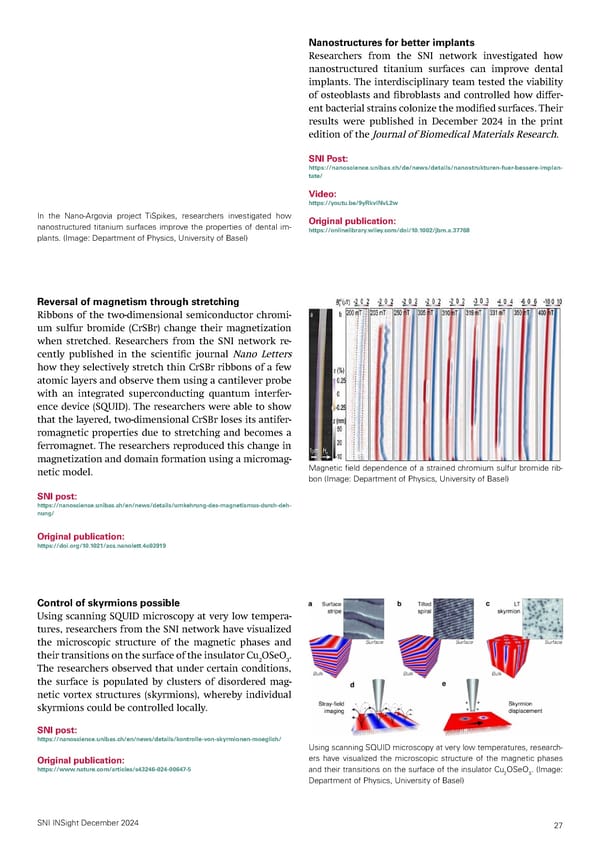

Friction depends on speed A team of researchers from the SNI network has recent- ly shown that, on the nanometer scale, frictional forces depend on speed. The scientists from the Department of Physics (University of Basel) moved the tip of an atomic force microscope (AFM) over a monolayer of molybdenum disul昀椀de on a gold surface. They found that the friction between the AFM tip and the surface decreases over a broad speed range of 10 to 100 nanometers per second. SNI post: https://nanoscience.unibas.ch/en/news/details/reibung-haengt-von-geschwindigkeit-ab/ Original publication: https://journals.aps.org/prl/abstract/10.1103/PhysRevLett.133.136201 Researchers use an AFM to investigate friction on the nanometer scale over a monolayer of molybdenum disul昀椀de on a gold surface. (Image: Department of Physics, University of Basel) Strong coupling between Andreev qubits mediated by a microwave resonator Physicists from the University of Basel have succeeded in coupling two Andreev qubits coherently over a macro- scopic distance for the 昀椀rst time. They achieved this with the help of microwave photons generated in a narrow su- perconducting resonator. The results of the experiments and accompanying calculations were recently published in Nature Physics, laying the foundation for the use of coupled Andreev qubits in quantum communication and Andreev qubit coupler: The long microwave resonator (a) couples two quantum computing. Andreev qubits (left (b), right (c)). The port in the center of image (a) is the readout port. The magni昀椀cation of a single nanowire (d) gives an idea of the SNI post: tiny size of a single qubit. The nanowire is coated with a superconductor https://nanoscience.unibas.ch/en/news/details/starke-kopplung-zwischen-andreev-qu- bits-ueber-einen-mikrowellenresonator/ (cyan). The actual Andreev bound state, which forms the qubit states, is located in the central white section marked by the red arrow. There is also Original publication: a similar nanowire on the left quantum device. (Image: C. Schönenberger, https://www.nature.com/articles/s41567-024-02630-w Department of Physics, University of Basel) New method for determining the exchange energy of 2D materials Researchers from the University of Basel have looked at how the ferromagnetic properties of electrons in the two-dimensional semiconductor molybdenum disul昀椀de can be better understood. They revealed a surprisingly simple way of measuring the energy needed to 昀氀ip an electron spin. SNI post: https://nanoscience.unibas.ch/en/news/details/neue-methode-zur-bestimmung-der-aus- tauschenergie-bei-2d-materialien/ The two-dimensional semiconductor material molybdenum disul昀椀de Original publication: is 昀椀lled with electrons (red spheres). The electron-electron interaction https://journals.aps.org/prl/abstract/10.1103/PhysRevLett.133.026501 causes the spins of all electrons (red arrows) to align in the same direc- tion. The exchange energy required to 昀氀ip a single electron spin in the ferromagnetic state can be determined by the separation between two speci昀椀c spectral lines. (Image: N. Leisgang, Harvard University, formerly Department of Physics, University of Basel/Scixel) SNI INSight December 2024 28
2D layer of phosphorus pentamers shows semicon- ductor properties on silver surface Phosphorus is an exciting element: It is essential for the survival of organisms and promises numerous electronic applications. With this in mind, researchers at the Uni- versity of Basel have synthesized two-dimensional layers containing rings of 昀椀ve phosphorus atoms (phosphorus pentamers (cyclo-P5)) on a silver surface. For the 昀椀rst time, they have been ableto investigate their electronic properties using combined atomic force and scanning tunneling spectroscopy. They found that the atomic phos- phorus pentamer layer retains its semiconductor prop- erties and forms a special electronic interface where the layer joins the silver surface (p-type semiconductor-metal When two-dimensional layers containing rings of 昀椀ve phosphorus atoms Schottky junction). (phosphorus pentamers) are formed on a sliver surface by self-assembly, the phosphorus layer retains its semiconductor properties and a special SNI post: interface (a p-type semiconductor-metal Schottky junction) forms at the https://nanoscience.unibas.ch/en/news/details/2d-schicht-aus-phosphor-pentam- interface with the silver surface. (Image: R. Pawlak, Department of Phys- eren-auch-auf-metall-mit-halbleitereigenschaften/ ics, University of Basel) Original publication: https://www.nature.com/articles/s41467-024-50862-4 Full house at the NanoTec Apéro The SNI nano community and interested researchers from industry and research institutions in Northwestern Switzerland were invited to the NanoTec Apéro in Novem- ber. The team from Park Innovaare hosted the event this year. After an interesting guided tour at the Paul Scherrer Institute PSI, all those present were given an insight into applied research as part of the Nano-Argovia program and had the opportunity to make new contacts and exchange ideas for projects. Impresssions: https://youtube.com/shorts/tDm5riP0UFo More than 70 participants gathered information at the NanoTec Apéro and used the opportunity to expand their network. Participation in Schnupper Schools at the University of Basel The Summer and Winter Schnupper Schools organized by the University of Basel also appeal to young people. The SNI team took part and gave interested students an insight into the nanosciences and provided information about the interdisciplinary nanosciences degree program. In addition, the participants are able to experience where “nano” plays a role by means of some experiments. Impressions: https://www.youtube.com/shorts/Jx_y-pC6TK0 There is a lot to try out at the Summer and Winter Schnupper Schools. SNI INSight December 2024 29
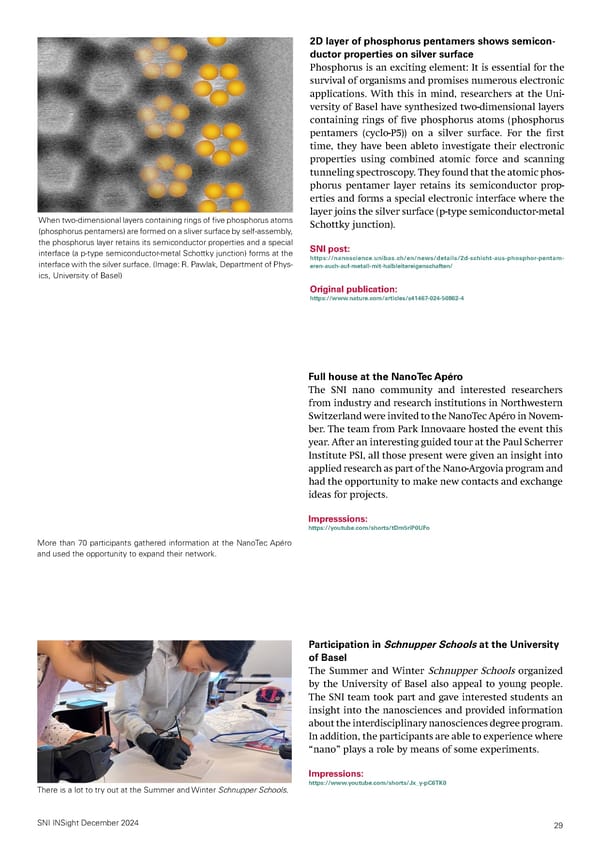
Exchange at the Rüeblimärt The SNI team comes into contact with di昀昀erent age groups – from toddlers to grandparents – at the annu- al Rüeblimärt in Aarau. This year at the SNI booth, ev- erybody interested was able to make pendants with UV warning beads and could learn a lot about light and the SNI at the same time. Impressions: https://www.youtube.com/shorts/RiD_1zbz4_0 The Rüeblimärt is a good opportunity to provide information about “Nano” and to offer entertaining and educational activities. (Image. K. Beyer-Hans) Raise the drawbridge! This year's SNI Christmas campaign for inventors and tin- kerers o昀昀ered the chance to win a mechanics set that can be used to build a gingerbread house with a drawbridge and cuckoo. Outreach manager Dr. Kerstin Beyer-Hans created comprehensive video instructions and recently sent 14 winners the necessary accessories with the Fisch- ertechnik set. We can't wait to see the pictures of the gingerbread houses that are created with it. Trailer: https://youtube.com/shorts/XUvkyMQ1NxI The drawbridge can be pulled down thanks to a hidden mechanism. Video instructions: (Image: K. Beyer-Hans, SNI) https://youtu.be/yfe2IT79ztE Participation in the Global Science Film Festival In November, the Global Science Film Festival 2024 took place, in which the SNI participated for the 昀椀rst time. We produced a 6-minute video about the development and application of the atomic force microscope (AFM). Professsor Christoph Gerber 昀椀rst explained the principle and recalled what was the intention behind the develop- ment of the AFM almost 40 years ago. Researchers from the SNI network then brie昀氀y explained the wide range of applications for which they need the very di昀昀erent AFMs. Video: The video about the atomic force microscope was shown as part of the https://youtu.be/WtpDUhmIjsE Global Science Film Festival at the Stadtkino in Basel. Contact with numerous young people at the Science Days in Europa Park Rust A highlight for the SNI outreach team every year is the participation in the Science Days in the Europa Park Rust (Germany). With the active support of nanoscience students, the SNI outreach team had the opportunity to interest numerous young people in science with experi- ments and activities. This year’s theme was “You and your DNA”. Impressions: At the Science Days, everything at the SNI stand revolved around DNA. https://youtube.com/shorts/Jx_y-pC6TK0 (Image: K. Beyer-Hans) SNI INSight December 2024 30
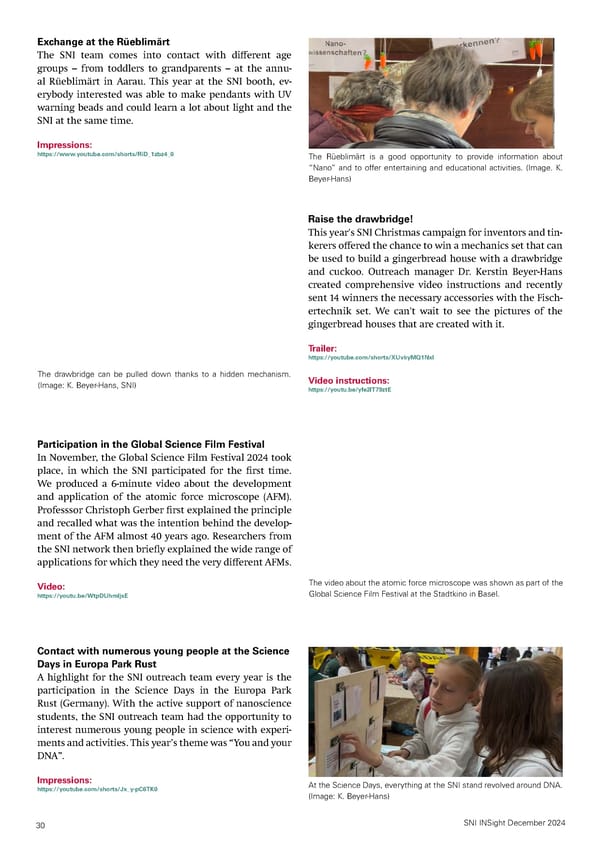


Master’s ceremony at Wild’sches Haus For several years now, we have celebrated the successful completion of their studies with graduates from the mas- ter’s program in nanosciences. It is a joyful event where everyone involved can see how the young scientists have developed since they came to the University of Basel to study nanosciences a few years ago. They all learned the basics in the natural sciences and then went on to spe- cialize. While they faced some challenging exams, the students all succeeded, in part thanks to the support the gave each other. At the end of October, the 2024 gradu- ates received their certi昀椀cates and were able to toast their achievements with their parents and some members of the SNI management team. We wish them all every suc- cess, happiness and ful昀椀llment on their future journey! The Master’s ceremony for the nanoscience students is the crowning glory of the interdisciplinary course. (Image: K. Schad) Impressions: https://youtube.com/shorts/s53w0E9BxEU Future Day 2024 Sixteen young people took part in the joint event orga- nized by the Department of Physics and the SNI. Using small experiments, the students were able to experience the exciting properties of sound waves for themselves. Dexterity was then required when soldering a game of skill. The Future Day gave the pupils an insight into the nanosciences and physics. Portrait of Sonja Schmid in UNI NOVA In the current issue of UNI NOVA an article about the work of Professor Sonja Schmid (Department of Chemis- try, University of Basel) has been published. Sonja Schmid is a member of the SNI network and develops methods to directly observe individual proteins at work. Among other things, she uses nanopores that allow individual molecules to pass through and thus provide information about their structure. UNI NOVA article: https://www.unibas.ch/en/News-Events/Uni-Nova/Uni-Nova-144/Uni-Nova-144-Mole- cules-in-full-gallop.html Video portrait Sonja Schmid: Sonja Schmid studied nanosciences in Basel. She now teaches and con- https://youtu.be/gVNoO2Dk6TY ducts research at the Department of Chemistry and is also a member of the SNI network. SNI INSight December 2024 31
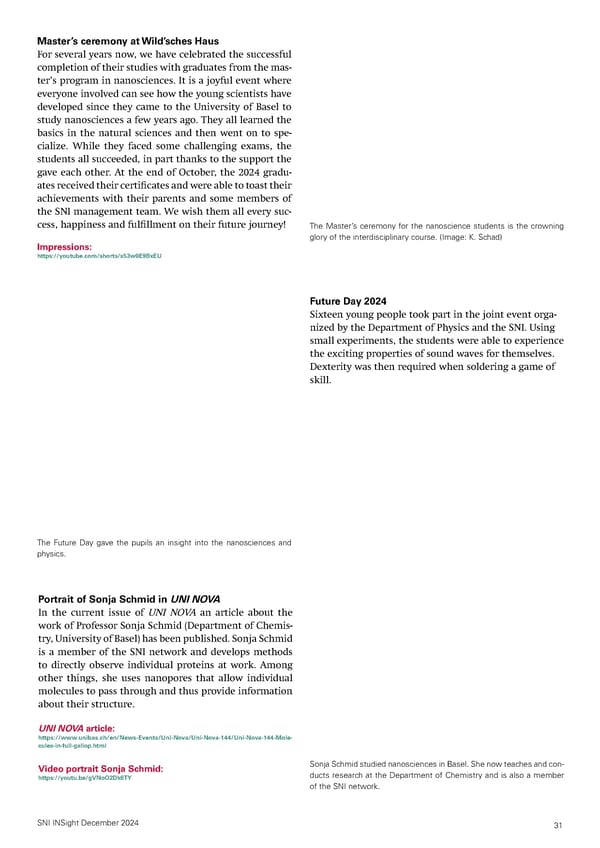

SNI now on BlueSky The SNI team will suspend its Twitter/X account and instead publish news from the network via BlueSky. The University of Basel, other network partners such as the University of Applied Sciences Northwestern Swit- zerland and the Paul Scherrer Institute PSI as well as various departments of the University of Basel are also active on BlueSky. “Follow us on @sniunibas.bsky.social and please share our news!” SNI INSight — Showcasing research and activities of the Swiss Nanoscience Institute Concept, text and layout: C. Möller, B. Utinger, M. Poggio Translations and proofreading: UNIWORKS (Erlangen, Germany) Image credits: C. Möller and named sources SNI INSight December 2024 32
Educating Talents since 1460. Swiss Nanoscience Institute University of Basel University of Basel Petersplatz 1 Klingelbergstrasse 82 4001 Basel 4056 Basel Switzerland Switzerland www.unibas.ch www.nanoscience.ch

